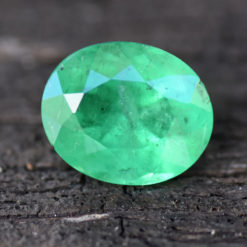No products in the cart.
Gemstone Information
What To Consider When Buying Emeralds
Emeralds have been a highly coveted gemstone for centuries. In fact, they are one of the traditional five cardinal gemstones, along with diamonds, rubies, sapphire and amethyst. Known for their stunning green color, emeralds are easily recognizable and come with the weight of prestige and class.
But buying an emerald can be tricky, and there are many pitfalls to watch out for. Here we outline the five main factors to consider when buying your own emerald stone.


1. Emerald color
Unlike a gemstone such as sapphire, which is found in a range of colors, emeralds are only found in green. While emeralds range in color from yellowish green to bluish green, the dominant color of emeralds is green. In fact, the very word ‘emerald’ is synonymous with the word green and if it’s not green, it’s not an emerald. When choosing the color of your emerald, consider the hue, tone and saturation. The best emerald colors are pure vivid green to bluish green. Always look for an emerald that has a neutral tone (neither too dark nor too light) with a vivid color and even saturation.2. Emerald durability
Emeralds are the most popular member of the distinguished beryl family, which includes Morganite, Aquamarine and Bixbite, among others. Emeralds are highly resistant to scratches and surface damage, ranking at 7.5 to 8 on the Mohs scale. However, due to the heavy inclusions that they often have, emeralds are not very durable. They tend to break or chip easily and are quite brittle. An emerald needs to be set in a protective setting and maintained with reasonable care to prolong its life.3. Emerald clarity
The main thing to watch out for when purchasing an emerald is the many inclusions that they typically have. Eye-clean emeralds are rare and most come with heavy inclusions. This makes the stone fragile and susceptible to breaking. Interestingly, although inclusions are generally not tolerated in gemstones, this is not the case with emeralds. Inclusions do not bring down the value of an emerald much. In fact, the jewelry world has given a romantic name to these inclusions – jardin- which means garden in French, in honor of the moss like thread green inclusions that run beneath the surface of emeralds.
4. Emerald treatments
Because most emeralds come with heavy inclusions, treating emeralds is a common industry practice. Most emeralds are fracture-filled to enhance the clarity and stability of the stone. Generally, oils and fillers are used to fill up the fractures within the stone. However, emeralds are never heat treated as this can damage an emerald. Over time, some emeralds may require re-oiling to maintain the stability and clarity of the stone. Purchasing an untreated emerald will be costly as these are rare and highly sought after.5. Emerald value
Emeralds have always been held in high esteem and this reflects in the price as well. A high quality, eye-clean emerald can rival the cost of other precious gemstones. Because emeralds are generally not found in large carat sizes, the price of an emerald increases considerably per carat. Check out the infographic below from Jewelry Shopping Guide that recaps our break down of what to consider when choosing an emerald.









